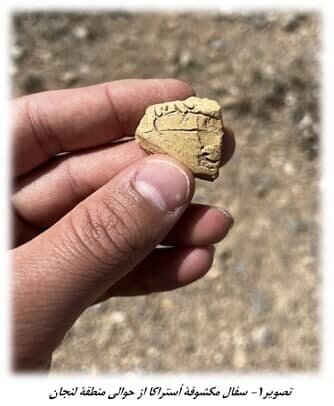Sassanid pottery fragment discovered in Isfahan province

TEHRAN— A fragment of inscribed pottery known as an ostraca has been identified in the Lenjan district of Iran’s Isfahan province.
Its content indicates the existence of a commercial and industrial settlement on the bank of Zayandehroud River.
The relic is estimated to date back to the Sassanid era. It can be considered one of the most important archeological findings of the current Iranian year and opens a new season in historical research in Lenjan, ISNA reported.
Aqil Aqili, head of the Archaeology Committee at the Isfahan Province Tourist Guides Association, said this accidental finding is the result of the continuous efforts of members of the Lenjan Heritage Preservation Association.
In a scientific visit to a site, which was made upon the invitation of Lenjan Heritage Preservation Association, a collection of archaeological evidence, including architectural remains, scattered potteries, metal slags, a stone tool, and an ostracon was identified in the Sassanid Pahlavi script.
“Following preliminary studies and reading the inscribed pottery, I understood that it is number six in Middle Persian script. This diagnosis was subsequently completed through correspondence and confirmation by Sirous Nasrollahzadeh, the head of Iran’s Linguistics Research Institute,” said Aqili.
Stressing that the identified pottery fragment is of high importance in terms of linguistics and archeology, he said, “It is written in Pahlavi script which was common in late Sassanid era. Today, its reading is difficult.”
This inscribed pottery was being used as a medium for writing information such as remittances, receipts, and exchanges of goods.
The ostracas found from Tappe Mill (a mill hill) in Varamin, Chaleh Tarkhan in Rey, Abunasr Fortress in Shiraz and pottery fragments found in Hegmataneh Hill in 1984 are considered to be in the same category of works.
He continued that given the researches conducted by Rasoul Bashash, a faculty member of Linguistics Research Institute on ostracas pertaining to Parthian era until inscribed potteries pottery pertaining to late Sassanid era and early Islamic era such as fragments found near Varamin, Chaleh Tarkhan in Rey, Shusha, Abunasr Fortress in Shiraz and Hegmataneh, the results are as follows: In Nisa city , every inscribed pottery was a part of an unbroken dish in which information like the name of gardens, their location, the delivery date of extracts of various fruits such as vinegar, the amount and name of the person who brought it has been registered.
In contrast, inscribed potteries found around Varamin and Chaleh Tarkhan and similar samples including the discussed pottery from Hegmataneh have been used in form of broken pieces like remittances or notes. Their writings don’t relate to the main content of the dish.
Aqili said the main topic of potteries pertaining to Nisa site has been the delivery of extracts like vinegar, but in pottery fragments surrounding Varamin, Chaleh Tarkhan and Hegmataneh, numerous agricultural items such as wheat flour, barley, and other goods have been registered.
These writings used to be delivered in form of remittances or receipts to the people.
Maybe, the waste lines drawn on many pottery fragments around Varamin were a sign of correction or settlement of the items recorded on these potteries.
The following can be interpreted from the content of this inscription, which is probably related to counting or exchanges: the discussed site has been one of the important industrial and commercial settlements in late Sassanid era and probably until the first Islamic centuries.
The presence of metal tools and slag remains also confirm the smelting and production of metals at this site.
He mentioned that Lenjan district particularly Khan Lenjan city has been known as one of the most prosperous settlements in the Jibal province (western Iran) and has been mentioned by geographers such as Ibn Hawqal, Al-Muqaddasi, and Yaqut Hamavi.
Khan Lenjan fortress which is located near the settlement, has played an important role in political, agricultural and defense development of the region, he added.
He continued that based on research conducted by archaeologist Jaleh Kamalizad, Khan Lenjan used to be a township inside Lenjan city in first Islamic centuries and a political subdivision of Isfahan.
Based on urban network theory, despite political affiliation with Isfahan, Khan Lenjan township had a pivotal role in Lenjan region. But it lost its prosperity in Ilkhanid era following the destruction of the mountain castle and transfer of the district center to the city of Firuzan.
Aqili said the gaze has turned to Lanjan once again following the recent finding, adding Lenjan district has been of high importance due to its strategic situation, access to Zayandehroud river and proximity to ancient routes throughout history.
He expressed the hope that with official registration of this site and beginning of scientific studies and excavations, new dimensions of economic, cultural and environmental history of this portion of Isfahan province are cleared.
KD
Leave a Comment